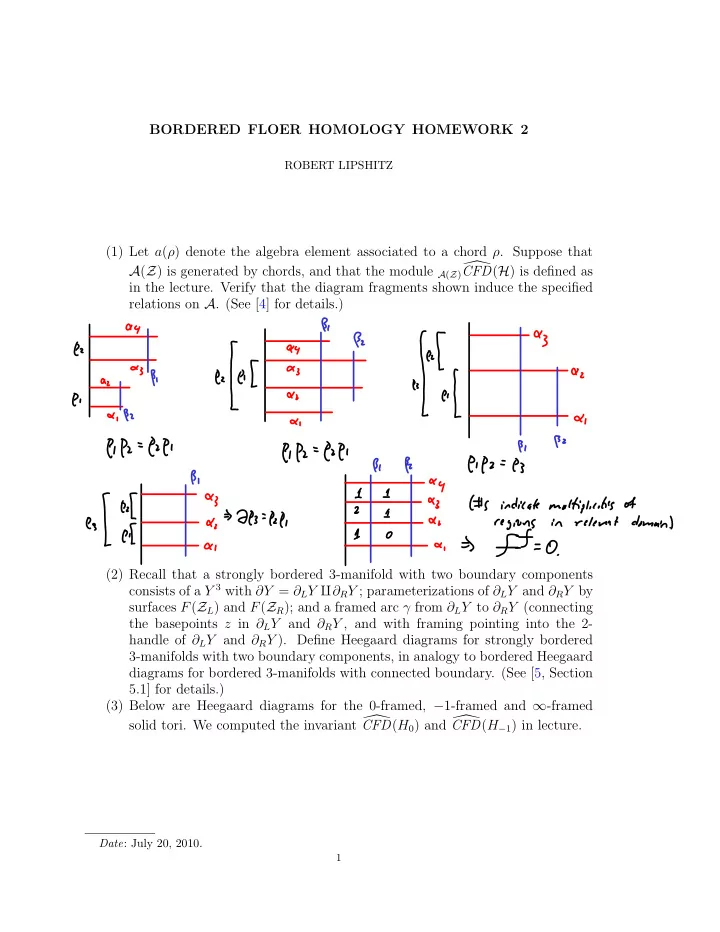

BORDERED FLOER HOMOLOGY HOMEWORK 2 ROBERT LIPSHITZ (1) Let a ( ρ ) denote the algebra element associated to a chord ρ . Suppose that A ( Z ) is generated by chords, and that the module A ( Z ) � CFD ( H ) is defined as in the lecture. Verify that the diagram fragments shown induce the specified relations on A . (See [4] for details.) (2) Recall that a strongly bordered 3-manifold with two boundary components consists of a Y 3 with ∂Y = ∂ L Y ∐ ∂ R Y ; parameterizations of ∂ L Y and ∂ R Y by surfaces F ( Z L ) and F ( Z R ); and a framed arc γ from ∂ L Y to ∂ R Y (connecting the basepoints z in ∂ L Y and ∂ R Y , and with framing pointing into the 2- handle of ∂ L Y and ∂ R Y ). Define Heegaard diagrams for strongly bordered 3-manifolds with two boundary components, in analogy to bordered Heegaard diagrams for bordered 3-manifolds with connected boundary. (See [5, Section 5.1] for details.) (3) Below are Heegaard diagrams for the 0-framed, − 1-framed and ∞ -framed solid tori. We computed the invariant � CFD ( H 0 ) and � CFD ( H − 1 ) in lecture. Date : July 20, 2010. 1
2 ROBERT LIPSHITZ (a) Compute � CFD ( H ∞ ). (b) Write down an exact sequence 0 → � CFD ( H ∞ ) → � CFD ( H − 1 ) → � CFD ( H 0 ) → 0 . What does this imply about � HF ( Y )? (4) This exercise relates to a diagram from [1] which can be used to show that � = Ext A ( − F ) ( � CFD ( Y 1 ) , � = Ext A ( F ) ( � CFA ( Y 1 ) , � HF ( − Y 1 ∪ F Y 2 ) ∼ CFD ( Y 2 )) ∼ CFA ( Y 2 )) . (See [1] or [2].) For notational convenience, we will work in the genus 1 case. Let AZ denote the following strongly bordered Heegaard diagram: (Unlike the diagrams we will use in lecture, this one has α -arcs meeting one boundary component and β -arcs meeting the other.) (a) Prove (by direct computation) that � CFAA ( AZ ) is isomorphic to A ( T 2 ), as an A ( T 2 )-bimodule. (Hint: AZ is a nice diagram ; see [3, Section 8], particularly Proposition 8.4.) (b) Aside: Use the pairing theorem and the previous part to show that if I Z denotes the identity Heegaard diagram for Z then � CFDA ( I ) ≃ A as an A -bimodule. (c) Given a Heegaard diagram H , let H be the orientation-reverse of H . Prove that � CFD ( H ) = � CFD ( H ) ∗ , the dual of � CFD ( H ). (d) Suppose H is a bordered Heegaard diagram for a 3-manifold Y with connected boundary. Let H β denote the result of relabeling the α -curves in H as β -curves and the β -curves as α -curves. Show that H β ∪ ∂ AZ is a bordered Heegaard diagram for − Y .
BORDERED FLOER HOMOLOGY HOMEWORK 2 3 (e) Challenge: Let H denote the result of gluing two copies of AZ along the boundary component intersecting the β -arcs (so H is an α - α -bordered Heegaard diagram.) What strongly bordered 3-manifold does H repre- sent? References [1] Denis Auroux, Fukaya categories of symmetric products and bordered Heegaard-Floer homology , 2010, arXiv:1001.4323. [2] Robert Lipshitz, Peter S. Ozsv´ ath, and Dylan P. Thurston, Heegaard Floer homology as morphism spaces , in preparation. [3] , Bordered Heegaard Floer homology: Invariance and pairing , 2008, arXiv:0810.0687. [4] , Slicing planar grid diagrams: A gentle introduction to bordered Heegaard Floer homology , 2008, arXiv:0810.0695. [5] , Bimodules in bordered Heegaard Floer homology , 2010, arXiv:1003.0598. Department of Mathematics, Columbia University, New York, NY 10027 E-mail address : lipshitz@math.columbia.edu
Recommend
More recommend